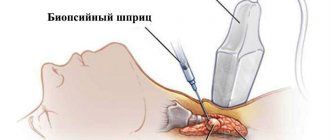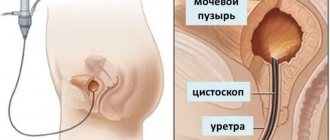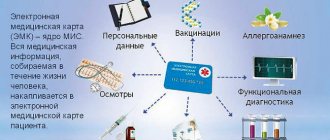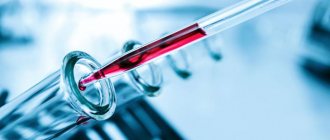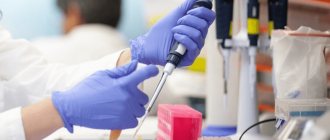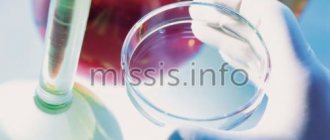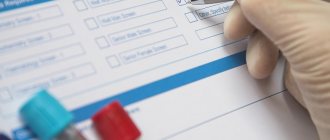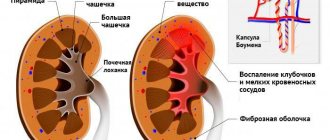PCR or polymerase chain reaction (Polymerase Chain Reaction) is a highly informative diagnostic method designed to identify genetic abnormalities and differentiate infectious diseases.
Clinical and laboratory assessment of biomaterial (blood, urine, etc.) is based on determining the genetic and molecular structure of the infectious agent, which eliminates the risk of a false-positive test result. For the scientific and medical value of the method, its developer Kary Mullis was awarded the Nobel Prize in 1993.
Polymerase chain reaction (PCR)
Polymerase chain reaction is a technology that allows you to isolate a section with a specific gene from a DNA double helix, multiply it and study it.
The discovery of PCR in biology and genetics can be compared in its significance to the invention of the microprocessor in the world of computer technology. The new possibilities that the technique provided excited the scientific world. The technique breathed new life into molecular genetic research, and made possible many tests that, for various reasons, were not profitable or were not available to the general public.
PCR for herpes zoster
The varicella zoster virus is the causative agent of chickenpox and herpes zoster.
Its DNA appears in the blood only during the acute phase of infection.
Chickenpox is usually diagnosed clinically.
Because it has quite characteristic symptoms.
While with herpes zoster, the origin of the disease is not always obvious.
Rashes do not appear immediately.
And if they appear, then the clinic may be atypical.
To confirm the diagnosis, blood testing using the PCR method can be used.
This diagnosis is rarely used.
But sometimes it becomes necessary in controversial clinical situations.
Advantages and disadvantages
Like most complex and high technologies, the polymerase method has both advantages and disadvantages. In two words;
From the poles:
- Excellent accuracy of research results. If all the technology is followed exactly, then the probability of error in the results tends to hundredths of a percent.
- Extensive selection of materials for analysis. The polymerase chain reaction allows you to extract from a sample any genetic material that it may contain. Thanks to this, you can equally successfully examine samples of saliva, blood, hair (with bulbs), nails, cigarette butts, etc.
- Ultra early diagnosis. There are no other universal methods capable of detecting any known infection at an early stage, before the onset of symptoms of an infectious disease. The same technique makes it possible to detect dormant hereditary diseases that manifest themselves differently in different generations.
- One PCR method has spawned many tests that meet different research topics in many areas of human activity.
From the Cons:
- High price. Of course, there are many tests, and they cost differently, but the most informative studies are still not cheap. But it’s worth considering that in just a couple of decades, technology has made a leap in cost from $100,000 for a complete DNA study of one person in a US laboratory, to a price tag of around 20-30 thousand rubles in your or a neighboring city.
- Lack of highly qualified specialists. This partly affects the final cost of testing - the genetics industry is relatively young and developing. Society does not have time to change to meet new needs for specialists, just as it itself is slowly getting used to new services and innovations.
- Test results will be distorted if the test sample is accidentally or intentionally contaminated. That moment when once again it seems that perfection is almost achieved. But the accuracy of the analysis is so high that this is its plus and minus at the same time.
Diagnostics
Testing for STIs includes the following diagnostic methods:
- Microscopic examination of a smear from the urethra and vagina. It can be simple and luminescent. The resulting sample is treated with special dyes or fluorochromes. Then the biomaterial is examined under a microscope.
- Cultural research. The sample is placed in a special nutrient medium where viruses and bacteria actively multiply.
- Enzyme immunoassay blood test. Detects specific antigens to a specific pathogen. It is based on the fact that antibodies bind exclusively to their own antigens and not to any others. In this way, it is possible to determine the type of pathogen.
- Blood test for torch infections. It is mandatory for all pregnant women. The abbreviation torch is made up of the first letters of the English names of the following infections: toxoplasmosis, syphilis, hepatitis, rubella, cytomegalovirus, herpes. These diseases have a negative impact on the fetus, causing abnormal intrauterine development. The woman's blood is taken and tested for antibodies to torque infections. The number of antibodies shows whether the woman is currently sick or has ever had these diseases. In the latter case there is no danger to the child. If the expectant mother becomes infected during pregnancy, she is offered to terminate the pregnancy.
PCR for STIs
DNA copying occurs only if it is present in a given sample. PCR for STIs is used for infections that occur latently. The advantages of this method include: speed, accuracy, information content.
The following diseases are studied using the PCR method:
- Chlamydia.
- Cytomegalovirus.
- HIV.
- Hepatitis.
- Ureaplasma.
- Gardnerellosis.
How are PCR results for STIs interpreted?
There can only be 2 options here: positive and negative. If the result is positive and there are no symptoms, then PCR is trusted, this means that the disease is latent or is at the preclinical stage. Also, specific tests are used to diagnose STIs, for example, the Wassermann reaction to diagnose syphilis. For hepatitis, liver tests are performed.
If there is a suspicion of a complication of an STD, then additional instrumental diagnostic methods are prescribed:
- Ultrasound of the pelvic organs in women, prostate gland in men.
- Blood test for tumor markers (in case of infection with human papillomavirus).
- Ultrasound of the liver to detect hepatitis.
Preparing for tests
In order to get the most reliable results, you need to prepare before taking a smear. Stop taking antibiotics, vaginal suppositories, and sprays within a week. Sexual contacts are excluded 3 days before the study. In women, a smear is taken after the end of menstruation. You should not urinate 3 hours before the test.
No specific preparation is required for analysis by PCR or ELISA.
Who needs diagnostics
Since PCR allows us to detect even hereditary diseases that migrate from generation to generation in their latent phase, conducting such a study will probably be useful for everyone. Of course, such knowledge does not seem urgent and necessary to everyone here and now. But it seems that as civilization develops, the successes of medicine and genetics will also increase. And new discoveries will allow us to make great progress in achieving longevity and health. By that time, a test for heredity may well become a routine and mandatory analysis for everyone.
Until this happens, the test is most often necessary in the following cases:
- If there is a suspicion of contracting the disease through sexual contact, or through an injection, contact with contaminated blood on mucous membranes or open wounds (a small cut is enough), an attack by wild animals, accidental injury to surrounding objects, for example, stepping on an old nail in a field.
- To clarify a diagnosis made by other means, especially in cases where treatment gives a non-specific reaction of the body.
- To establish family ties to claim inheritance rights, or in alimony litigation.
- To identify a person's identity.
Other tests are more related to areas of individual interest. Who is interested in knowing what the transcript of all the nationalities in his family shows? Someone is trying to plan for a future child and is being tested for compatibility. Someone decided to replace the DNA test with a nutritionist and receive individual instructions and advice on proper nutrition.
When is the PCR test done?
Anyone can take a PCR test for coronavirus, even without visible symptoms of the disease. If the virus has entered the body, testing will show this. But today it is not done for everyone who wants it. Only doctors refer for the test and give priority to the following population groups:
- citizens with signs of a cold or flu who arrived in the next 2 weeks from countries affected by the coronavirus situation, as well as persons who had contact with them;
- persons over 60 years of age who consulted a doctor with signs of acute respiratory viral infection;
- everyone who has been diagnosed with pneumonia in the coming days;
- persons with chronic diseases: cardiovascular, endocrine, oncological;
- contacted with citizens whose diagnosis of COVID‑19 was confirmed.
They are also sent for analysis if a positive result is detected during a rapid test.
Specifics
The specificity of all tests based on the PCR examination method is that its results cannot be false positive. That is, if the results of the analysis indicate the presence of DNA of the causative agent of the disease, it is definitely present in the sample. But because of such precision, if the entire process is not carried out under sterile conditions, there is a risk of incurring the cost of the study and failing it when the contamination is detected and identified. Which reveals some weakness of the technique.
Therefore, it is best to contact a specialized clinic with its own well-equipped laboratory for DNA testing. The creation of such institutions requires large investments, both in equipment and qualified personnel.
Diagnosis of infections using PCR: what is it?
The list of tests performed using PCR diagnostics is expanding every day. What is this method, how is it carried out and what are its advantages? These and other questions are answered by Vladislav Aleksandrovich Cherednichenko, infectious disease doctor, deputy director for development at Clinic Expert Voronezh.
— Vladislav Aleksandrovich, PCR - what is it?
PCR or, in other words, polymerase chain reaction is a modern, highly informative method of molecular genetic diagnostics, actively used to identify various infectious and hereditary diseases in humans.
American biochemist Kary Mullis was awarded the Nobel Prize for the creation of the PCR method.
— How long ago did PCR diagnostics appear and how widespread is it today?
The official date of invention of this diagnostic method is considered to be 1983, and the “parent” is the American biochemist Kary Mullis. He wanted to create a method through which it would be possible to amplify DNA (increase the number of its copies) through multiple successive doublings of the original DNA molecule using the enzyme DNA polymerase. This event was truly revolutionary and subsequently had a serious impact on the development of molecular biology, genetics and medicine. This is confirmed by the Nobel Prize in Chemistry, which was awarded to K. Mullis in 1993.
Kary Mullis
Today, it is almost impossible to do without PCR diagnostics in clinical medicine. The highest sensitivity of the method allows you to rely on it when identifying various infectious agents in different aspects - both qualitatively (there is a pathogen or not) and quantitatively (how many microorganisms there are).
In addition to medicine, the method has found application in genetics, criminology, and archeology.
— To identify which diseases is PCR prescribed?
The versatility of the method allows it to be used for diagnosing most pathologies of a viral, bacterial, fungal nature, as well as those caused by helminths and protozoa. For example, the PCR method is actively used to detect infectious diseases such as HIV, hepatitis of all types, ureaplasmosis, chlamydia, mycoplasmosis, candidiasis, mononucleosis, trichomoniasis, herpes infections, salmonellosis, tuberculosis and many others.
Read materials on the topic:
"Silent killer" of his contemporaries
How to protect yourself from Botkin's disease?
Shield and sword against hepatitis C. How to protect yourself and your loved ones?
Tuberculosis: a disease that knows no borders
— What biological material is examined during PCR diagnostics?
All biological media and human fluids: blood, urine, feces, sputum, saliva, prostate juice, sperm, cerebrospinal and joint fluid, and others. The choice of biological material depends on the location of the pathogen. For example, to perform PCR to detect chlamydia, ureaplasma or herpes, scrapings from the mucous membranes are used, to perform PCR for hepatitis A, B, C, etc., blood is required, and PCR analysis to detect pulmonary tuberculosis will be as informative as possible when examining the patient’s sputum . The use of the polymerase chain reaction method in the study of biopsies from the gastrointestinal tract makes it possible to detect Helicobacter pylori infection.
About Helicobacter pylori and the history of its discovery - our articles:
Living in acid: what do we know about Helicobacter pylori
The risk is on the verge. How was Helicobacter pylori discovered?
— How is the PCR procedure carried out? What is its essence?
Any living organism has its own unique “calling card” - a DNA or RNA molecule with a set of genes located in it. This molecule consists of units - nucleotides. Each microbial agent has nucleotides arranged in a specific order and combination. Biomaterial taken from a patient may contain fragments of DNA or RNA of an infectious pathogen, but it is usually extremely small to determine whether the microorganism belongs to any of the species. This is where the polymerase chain reaction comes to the rescue.
The essence of PCR is that a small amount of DNA or RNA-containing material is taken for research, and the reaction helps to increase the amount of genetic material belonging to a particular pathogen, so its identification becomes possible.
The patient is usually sent for PCR diagnostics by the attending physician. In the treatment room or in the specialist’s office, the necessary biomaterial is taken from the patient, which is packaged in compliance with sterility, temperature conditions and labeling. Then the biomaterial is sent to a PCR laboratory, where it is placed in a special apparatus in which three stages of transformation of the biomaterial occur.
After 1-2 days, the patient receives the results of the study.
— Is special preparation required to conduct a PCR test?
No, but it is recommended to follow some rules. Blood for analysis is donated on an empty stomach. Saliva, sputum, urine and feces are collected in a clean container. Before submitting material from the genital tract for the diagnosis of diseases of the genitourinary system, you should abstain from sexual activity for two days. It is also advisable to clarify the specifics of preparation in a medical institution or laboratory before the study.
How to prepare for other common tests? Read about this and more below:
How to properly take a general blood test?
What does a biochemical blood test show?
Not only a colonoscopy: what will a stool test tell you?
— Vladislav Aleksandrovich, tell us about the advantages and disadvantages of this research method.
In my opinion, there are no disadvantages to PCR diagnostics, provided that the analysis technology and the purity of the material are strictly adhered to.
The main advantage of this method is its high sensitivity and the ability to detect the pathogen itself, both qualitatively and quantitatively. Determining the number of microorganisms is a good help for the attending physician, as it allows one to assess the degree of damage, as well as the effectiveness of the treatment.
An undeniable advantage of PCR diagnostics is also the suitability of various types of patient biological material: blood, urine, feces, sperm, etc. Several pathogens can be detected in one sample of material. One of the advantages of PCR diagnostics is that it is a hardware technique that practically eliminates subjectivity in the assessment of biological material.
Interviewed by Sevilya Ibraimova
The editors also recommend:
Viruses and bacteria - what is the fundamental difference?
How dangerous are TORCH infections?
Herpes: how to recognize and cure?
I'll die falling face down on a typewriter keyboard
For reference:
Cherednichenko Vladislav Alexandrovich
In 2000 he graduated from Donetsk State Medical University named after M. Gorky with a degree in General Medicine.
In 2002, he completed his master’s degree at the Ukrainian Military Medical Academy (Kiev) with a degree in infectious disease doctor.
Deputy Medical Director for Regional Development at Clinic Expert Voronezh. Receives at the address: st. Pushkinskaya, 11.
Application of PCR
The range of applications of polymerase chain reaction technology is so wide that it allows for various molecular genetic studies. The method is used both for DNA tests, which have become quick and routine, and for studying DNA structures that have not yet been studied
And everyone thanks to the fact that technology makes it possible to extract a region of interest to a researcher from any amount of DNA, multiply it and conduct an in-depth analysis of its properties in various forms by studying chemical reactions. Thus, PCR reveals and allows one to observe dependencies between genes and study their joint reactions to artificial experimental stimuli.
How to get tested
As we have already said, the doctor may ask you to submit various biological material for research, so preparation for the procedure depends on what exactly you are being tested for.
Donation of saliva, urine, sperm
If a specialist takes saliva for analysis, you should not eat or take medications for at least 4 hours before the procedure. Before taking the test, fill your mouth with boiled water to rinse it.
If the doctor asked you to take urine, then you only need to take morning urine. Before collecting urine for analysis, you must wash yourself thoroughly. To ensure that the material is clean, without foreign impurities, it is better for women to insert a tampon into the vagina, and for men to try to pull back the skin fold. The container should contain at least 50-60 ml of urine.
If a man's sperm is taken for analysis, he must abstain from sexual intercourse for at least 3 days before donating it. Also, at this time you should not visit the sauna, take a hot bath, drink alcohol, or eat spicy food. It is important before taking the test not to go to the toilet for at least 3 hours, i.e. refrain from urinating.
If the doctor asked you to donate blood, then this is done in the morning, on an empty stomach. Before this, you should not indulge in fatty foods and drink alcoholic beverages.
Carrying out PCR
PCR test, what is it? PCR diagnostics are carried out in a special apparatus - an amplifactor. This is a device in which test tubes with biological samples are installed. Depending on the study, the amplifactor is adjusted to the required number of cycles and begins to alternately heat and cool the test tubes in which reactions are taking place at this time. This creates temperature uniformity throughout the entire internal chamber; the required temperature is set literally in an instant and adjusted with an accuracy of 0.1 degrees.
Such precision during heating and cooling is necessary in order not to exceed threshold values and not spoil the biomaterial.
What is needed to carry out, or what determines PCR:
- Buffer solution;
- DNA matrix containing the desired gene region for amplification;
- Heat-stable DNA polymerase;
- Mg2+ ions;
- Two short fragments of nucleic acid to trigger the synthesis of a complementary strand using DNA polymerase.
Blood test for parasites using PCR
DNA of listeria and toxoplasma is determined in the blood.
These are single-celled parasites.
Listeriosis is most often contracted through food.
The disease can cause complications and cause inflammation of the structures of the central nervous system.
At risk are pregnant women, the elderly, people with immunodeficiency or cancer.
In most cases, listeriosis occurs as an intestinal infection.
Its septic form is very dangerous and often leads to death.
Toxoplasma is a common, not so dangerous infection.
It poses the greatest threat to pregnant women.
Analysis is prescribed when:
- recurrent miscarriage
- prolonged fever of unknown origin
- HIV
- enlarged liver and spleen
All pregnant women are tested for toxoplasma.
Although they are usually examined using serological methods.
The disease often manifests against the background of immunodeficiency.
Progress of the reaction
One reaction cycle occurs in three stages:
- Heating stage. The DNA helix in the sample is heated for a period of half to two minutes at 94-96 degrees. When exposed to high temperatures, DNA chains break down into separate fragments
- At the second stage, the necessary fragments are caught using primers and fused. This stage takes place at a temperature slightly lower, 4-5 degrees, and is called “annealing.” The duration of the stage also varies from half to two minutes.
- A special enzyme is added to start the self-reproduction (synthesis) of the “caught” gene region - DNA polymerase. And this enzyme starts the fragment doubling reaction, using the starting fragment as a template for synthesizing a copy. The reaction takes place at 72 degrees for 10 to 12 minutes.
Typically, one study consists of 20 to 35 similar cycles.
What infections can be diagnosed using PCR?
PCR helps diagnose infections of the male and female genitourinary system: ureaplasmosis, chlamydia, herpes, gonorrhea, mycoplasmosis, gardnerellosis, human papillomavirus infection. In gastroenterology, the method is used to identify the causative agent of peptic ulcer H. pylori, in pulmonology - for the diagnosis of tuberculosis, pneumonia caused by bacteria and viruses.
PCR helps to detect pathogens of diphtheria, intestinal infections (salmonellosis), viral hepatitis (B, C, G), oncoviruses, cytomegaloviruses.
Taking tests
PCR analysis requires special care. Since the main requirement of the entire procedure is a perfectly clean sample for testing, many tests are taken directly in the clinic: blood, other physiological fluids, and sometimes tissues.
The simplest method of collecting biomaterial is to collect saliva from the inside of the mouth on a cotton swab. The method is simple, can be done at home, but is not suitable for all tests.
Non-standard samples are prepared separately, which is individual and it is better to consult with the clinic in what order it will accept them.
What infections does the PCR smear test for?
PCR is sensitive to any known microorganisms.
That is, it is able to isolate the DNA of any pathogen: bacteria, viruses, protozoa, fungi.
The list of pathogens that are detected by PCR coincides with the list of infectious agents that can cause STIs.
- syphilis
- trichomoniasis
- chlamydia
- mycoplasma and ureaplasma
- gonorrhea
- HPV
- chancroid
- gardnerellosis
- genital or other herpes
- donovanosis
- cytomegalovirus infection
- HIV
- viral hepatitis
- molluscum contagiosum
- Kaposi's sarcoma
- candidiasis
- phthiriasis
- scabies
Preparation for women
For women, there are slightly more instructions, prohibitions and recommendations for passing:
- Do not overdo intimate hygiene and do not use soaps with antibiotics.
- In general, any use of antibiotics more than 4 weeks before the test is prohibited.
- There are also prohibitions on specific intimate products. Therefore, to ensure compliance with tolerances, it is easier to limit ourselves to standard hygiene. And it is advisable to limit yourself a month before taking the tests.
- It is prohibited to take tests on particularly acute days of the women's menstrual cycle.
- Close intimate contact is prohibited 48 hours before the procedures.
Technology for collecting smears for PCR
For women, some preparation is required for smear collection, including PCR testing.
Preparation for smear collection:
- on the day of sampling, do not wash or douche
- do not urinate at least 2 hours before collection
- smears are not collected during menstruation and for 2 days after it
- the day before, do not use antiseptic and antibacterial agents, including topically (suppositories, irrigation, tablets, injections)
- antibiotics must be taken in a course, but the first study is prescribed a month after the last dose
Let's look at how exactly a smear is taken for PCR in women. The procedure is performed by a gynecologist, urologist, venereologist or midwife using a sterile swab.
They are carried out at the places where the material is taken, in a circle, without pressing:
- urethra
- cervical canal
- vaginal wall
- rectal ampulla
- mucous membrane of the eye and lower eyelid
- posterior wall of the pharynx and tonsils
The swab is placed in a sterile tube or passed over a glass slide with a fixative. After which the material is delivered to the laboratory.
The scraping is carried out with the same sterile swab. Only with rotational movements and applying some force or a special “brush”. Next, the brush or swab is also placed in a sterile test tube or passed over a glass slide.
Urine is collected for PCR in a sterile container, the first 50 ml, without isolating the middle portion. Next, the container is closed and delivered to the laboratory.
Sputum collection for PCR is carried out in a sterile container. The patient is first asked to drink plenty of fluids.
In the morning, the patient is asked to cough and separate the sputum into a sterile container. This study is used to diagnose tuberculosis, chlamydia and mycoplasmosis.
Interpretation of PCR results
When it comes only to identifying a disease, from the entire range of possibilities for a full diagnosis, the decoding, as well as the test itself, are quite simple. The high accuracy of the analysis makes it possible to identify the most insignificant traces of the presence of foreign DNA, multiply it to the required volumes and examine it.
Out of habit, such an accurate diagnosis, which detects diseases at an extremely early stage, can cause distrust in the results. There are no symptoms, I feel good, but the test results say otherwise. If in a topic about health problems one can somehow talk about luck, then identifying a disease so early and immediately starting its treatment is a kind of luck.
Meanwhile, behind the decoding of each known gene there are decades of continuous research from leading universities around the world. For example, one of the longest known research projects, the Human Genome Project, lasted almost 13 years in a row. During these studies alone, about 25 thousand genes that make up human DNA were studied.
Rules for collecting material for analysis
Foreign DNA and RNA can be detected by examining a variety of biological fluids of a particular person. In order to examine a person for the presence of certain sexually transmitted infections, it is necessary to take a sample of genital discharge (smear or scraping) from the patient and his urine.
If there is a need to examine a person for various types of infections (HIV, herpes, hepatitis and others), then a PCR test is taken, for which the patient’s blood is used.
To diagnose herpetic lesions, mononucleosis, you need to take a smear from the patient’s mouth. To confirm CMV infection, the patient's urine is taken for analysis. There are cases when the cerebrospinal fluid is examined to determine the causes of neurological abnormalities that have arisen.
In this case, a pulmonologist examines sputum and fluid from the pleura of a particular patient using PCR.
If a newborn child is suspected of having an intrauterine infection, doctors take an analysis of the amniotic fluid from the pregnant woman and a piece of placenta tissue.
HIV testing
Non-HIV DNA testing has several specific features and recommendations:
- If unwanted contact with an HIV-infected person occurs, then diagnostic tests must be taken no earlier than 14 days after it.
- During diagnostics, the sample is searched not for the DNA virus, but for cells already damaged by it. These cells carry specific viral information, which self-copies into uninfected cells.
- Although immunodeficiency syndrome remains one of the most dangerous diseases. But, a period of media hysteria about it greatly overshadowed its already dangerous features. The infectiousness even when infected blood enters healthy blood is 85%, which is not 100%. For other contacts, it is no more than 1% to 10%.
- The time frame for obtaining ready test results ranges from 4 to 7 days.
What needs to be taken for PCR
Strokes:
- from the urethra
- from the rectum
- from the mucous membrane of the eye and lower eyelid
- from the cervical canal
- from the vagina
- from the throat
- from the surface of skin rashes and ulcers
Blood, prostate secretions, water, soil, swabs from surfaces and even food.
To whom do we owe the emergence of the PCR method?
According to American biochemist Kary Mullis, the idea of identifying living organisms by a short section of their genetic code (DNA) came to his mind in 1983, on his way home from work. And this idea was based on the work of another American biochemist, Arthur Kornberg, which at one time did not find a response from the scientific community.
Kerry allowed the possibility of taking a DNA molecule of any organism, using high temperature to “unravel” its helix into two strands, using specific markers-primers to mark sections of DNA unique to this microorganism, and then, using the enzyme DNA polymerase, to create from two strands of two new DNA molecules. But they already contain labeled primers. And then all that remains is to simply look for these areas in the diagnostic material.
As a result, the CETUS corporation, where Mulis worked, allocated him a team of scientists. And in 1985, in the publication of the American Society of Human Genetics, a publication appeared with a theoretical justification for PCR as a method for identifying the genetic material of living organisms.
Cost of PCR analysis
| Name of service | price, rub. |
| PCR-6 (Ureaplasma species, Chlamydia trachomatis, Mycoplasma genitalium, Mycoplasma hominis, Trichomonas vaginalis, Gardnerella vaginalis) | 1345 |
| PCR-9 (Cytomegalovirus, Herpes Simplex Virus 1/2, Chlamydia trachomatis, Mycoplasma genitalium, Mycoplasma hominis, Ureaplasma parvum, Ureaplasma urealyticum, Candida albicans, Gardnerella vaginalis) | 2100 |
| PCR-10 (Cytomegalovirus, Herpes Simplex Virus 1/2, Chlamydia trachomatis, Mycoplasma genitalium, Mycoplasma hominis, Ureaplasma parvum, Ureaplasma urealyticum, Candida albicans, Gardnerella vaginalis, Human Papillomavirus of high carcinogenic risk) | 2975 |
| PCR-12 | 3425 |
| PCR-13 | 3690 |
In our clinic, PCR tests can be done quickly, without waiting in line. The analysis is carried out on modern equipment. Sign up by phone +7 (495) 308-39-92.

